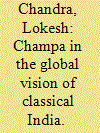|
|
|
Sort Order |
|
|
|
Items / Page
|
|
|
|
|
|
|
| Srl | Item |
| 1 |
ID:
141382


|
|
|
|
|
| Summary/Abstract |
The foundation and flourishing of Champa on the major marine trade route from Kanchi to Canton, or from the SE Asian isles to Canton, was part of a new historic phenomenon of the fast emergence of cultural kingdoms from tribal orders. The new paradigm was the empowerment of the dormant energy of the non-alphabetic tribes by enriching them with a writing system and thinking patterns; establishing kingdoms with a king, ministers, nobility and State functionaries; setting up palaces and temples; the rise of an intellectual class and priestly orders. Emperor Asoka sought the substitution of war drums by the drums of Dharma, bherighosa became dhammaghosa. He initiated this process of culturation by sending his son Mahendra and his daughter Sanghamitra to Srilanka by deputing his ministers to Khotan and crowning his son as the first “King of Khotan,” by planning his son Kunala to be the King of Kucha, and so on. This sowing of intellectual seeds in the immensity of the regions was the rise of a new order of a spiritual culture and secular civilisation in the whole of Asia. The theodiversity, pluralism of life styles, alongwith an organised state, economy and strategic systems of India became the dawn of a new age in the SE Asian region upto mainland China. Indian savants, princes and merchants envisioned Suvarnadvipa in their quest of affluence of life.
|
|
|
|
|
|
|
|
|
|
|
|
|
|
|
|
| 2 |
ID:
148878


|
|
|
|
|
| Summary/Abstract |
The French archaeologists carried excavations in Bình Ðinh Province
during early years of the twentieth century, and the Champa artifacts,
discovered during the same period, have been preserved in some
Museums in Vietnam and France, such as Museum of Vietnam History
in Hochiminh City, the Museum of Chãm Sculptures in Ðà Nang and
Museum of Natural History in France. However, archaeological finds
of Champa arts, discovered after 1975, are only exhibited in Bình
Ðinh Provincial Museum. But, finds of two excavations in An Nhon
and Tây Son Districts conducted in 2002, 2004 and the recent
excavation in Phú Yên Province in 2008 haven’t been still announced
in any monographs. For this reason, my research paper is for the
purpose of the studies of the latest archaeological achievements
reflecting the progress of Champa art as well as art relationship of the
Champa and contiguous kingdoms in Vijaya period. In the eleventh
century. The Champa art has been deeply influenced by other arts
such as the arts of India, Ðai Viet (former Vietnam), Angkor and Java.
Keywords: Kingdom of Champa, Hinduism Sculpture, Trinity
Divinities, Sacred animal, Vijaya, Bình Ðinh, Tháp Mam style, Bình
Ð Provincial Museum.
|
|
|
|
|
|
|
|
|
|
|
|
|
|
|
|
|
|
|
|
|